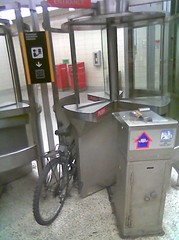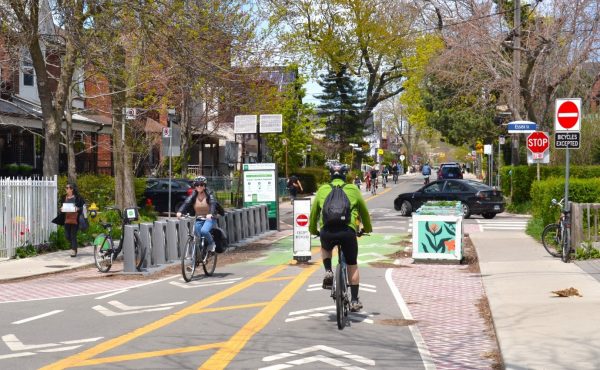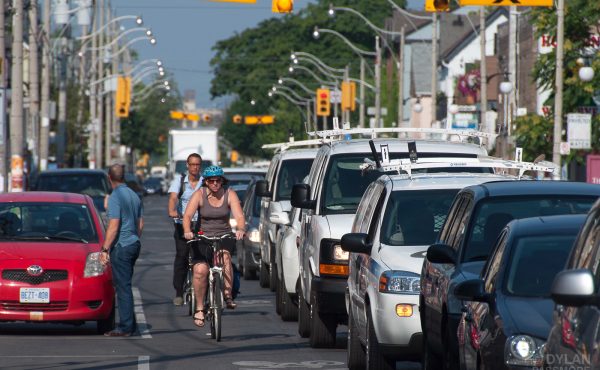
In the last two issues of Momentum magazine there has been a feature (which I believe will be reoccurring throughout future issues as well) called “Cycling for Everyone”.
The first installment in issue #35, “Provision of Cycling Rights of Way,” deals with the creation of a cycling environment that is separate, or at least protected, from the larger vehicles on the road. With examples given from European cycling havens such as Germany, Denmark, and the Netherlands, it’s almost enough to get us North Americans rather jealous.
But what’s good for a Dutch gander isn’t necessarily good for the Canadian Goose. The basic principals behind cycling right-of-way are the same on both sides of the pond but the people it needs to be tailored to are quite different. These European countries have a much higher percentage of cyclists than we do in Canada or The States (as well as having a more statistically well-rounded cycling demographic instead of our young male—dominated scene). With cycling ridership levels in the 20-30% range, compared to North America’s meager 1%, it is obvious that Euro-cyclists will have a lot more infrastructure that is catered to them. Also, North American cities are, for the most part, not as dense as European counterparts — which means longer commutes and more car-dependency — the rolling tides of suburban neighborhoods which tidyly border our cities can be a vertiable no-man’s land for cycling (I touch on this in the forthcoming issue of Spacing), at least in any sort of way comparable to Europe. No matter how many kilometers of bike lanes are constructed in-and-around the city, it seems very unlikely to see a big rise in 905-ers cycling into downtown every day.
But that doesn’t mean that there isn’t anything to learn from these German, Danish, and Dutch models.
Just because we may not be boasting the numbers like Europe does, that doesn’t mean that big cities around Canada and the U.S. don’t need complete and integrated bike systems. Toronto, for instance, is a long way away from this. Even when (if) the Bike Plan is completed, just having designated spaces doesn’t make for a very well-rounded infrastructure. It’s like putting a child in a play pen without any toys.
Although cycling numbers may be up in Toronto, we aren’t going to hit European levels any time soon. I think the biggest potential draw the city has towards building bike ridership would be in the bike-and-ride department. Back in the 80s Toronto used to be at the forefront of encouraging the combination of cycling with public transportation as the TTC was one of the few transit agencies that allowed bikes on their vehicles. As other cities such as San Fransisco and Seattle started to catch up, Toronto began to stagnate, falling further down the ladder of bike-friendliness through the 90s. A major part of the City’s Bike Plan is focused on reestablishing a strong relationship with cycling and transit again.

In surveys done by the City in order to establish the needs of local cyclists before the Bike Plan was drafted, almost half of the non-cyclists questioned cited “distance” as the reason for not riding (see what I mean about density?). Toronto has twice as much area as Berlin with only a slightly larger population, leaving Berlin with a much higher density (almost 40 people per hectare, compared to Toronto’s 27). Making cycling to transit (or vice versa) transitions as painless as possible may help the trips to work or school seem more fathomable. The TTC has already started the ball rolling on this with increasing the number of routes equipped with bike racks (Note: I take a fold-up on my commute so I have never used these racks. I would like to know from any Spacing readers how they feel about using these racks?), but there are still a lot of kinks to work out. Some stations have those revolving door entrances/exits that (as you can see in the photo above) are near impossible to navigate with a bike. But the big issue is that bikes aren’t allowed on the subway during peak hours (which is reasonable considering what the subway is like during peak hours), but this hampers those who would need to cycle before and after their transit trip. As unfortunate as it is, I don’t see any sort of easy fix for this popping up in the near future.

It may come as a surprise, but Momentum actually named Toronto as a leader in one area of cycling: Parking. Just like cars and butts, having a place to park your bike is a necessity. In the most recent Cycling for Everyone article, aptly named “Bike Parking“, Toronto, along with sister city Chicago, were hailed as the North American role models. I’m sure no mention is really needed for the 15,000 post-and-rings we have around the city, they’re so popular that they seem to be popping up in people’s own yards for personal use. The City plans to install a lot more over the next few years, same with bike lockers.
Maybe one of Toronto’s best moves concerning bike parking would be the 1993 zoning bylaw requiring bike parking for every residential or commercial building over 2,500 square metres.
But Chicago is a big up and comer. Over the past 15 years, more bike posts have been installed across Chicago than any other city in the U.S. and are getting pretty close to Toronto’s numbers. Also, the CTA has the most indoor/sheltered bike parking out of every transit system in North America, and they’re still building more and improving designs.
Toronto is still (hopefully only) a few years from seeing the completion of the Bike Plan. While it should give Toronto a big push back into the cycling scene, by no means it should be the end of the line. Getting the proposed bike network up and running should only be the beginning of continous work to keep our bike infrastructure Toronto-specific, as well as world class.
photo of Copenhagen cyclist by malouette, photo of TTC turnstile by orbz, photo of post-and-ring by Bitpicture




16 comments
What the Copenhagen photo heading the post does not show clearly is their bicycle lanes are curbed and raised slightly–3-4 inches–above the level of the road, and the sidewalk a similar amount over the bike lanes, so everyone is protected from invasion by another mode of transportation. I was told also, when I was in Copenhagen in September, that the person in the car one day was likely to be on a bicycle the next, which makes for more respect between modes.
What we in Toronto are doing, though not quickly enough, is building off-road networks of pedestrian and cycle paths. They emerge from linking together parklands,like those of the linear park along the rail corridor under Spadina and Bathurst, past Fort York to the proposed pedestrian-cyclist bridge at Strachan, and on to Railpath, if the railways will co-operate. Only the government of Canada can alter the privileges of the railways to ensure their
corridors deliver maximum public benefit, particularly in urban areas.
A good idea that popped up here some time ago that hasn’t been implemented is placing the bike lane between parked cars and the sidewalk. Might be less inexpensive than pouring a little concrete divide.
I recall that some people are against the Railpath because they feel that the rail corridor should remain exclusively for the use of the railways. Yet the narrow path wouldn’t use that much land and would provide a quality route for residents of the fairly dense west end to cycle downtown. There is a lot of land in that corridor.
Picture a bicycle commute in urban Toronto where the majority of the trip is not on roads. That kind of more comfortable commute is what the majority of people of different ages want, not the stress of contending for space on infrastructure that was blatantly not designed for your kind vehicle. I can’t imagine what cycling across the 401 must be like at rush hour with cars hurrying onto the ramps.
We need some serious investment in bicycle infrastructure, not afterthought bike lanes in door zones and quiet streets which were safe for cycling in the first place. Complete that Railpath downtown, come up with better solutions than bollards on bike paths (perhaps small underpasses?), and rebuild park bridges so that cyclists aren’t forced to dismount (I’m thinking of the one crossing the Humber near Lambton).
The % of commutes by bicycle can be increased several times with some real infrastructure for cyclists. (And also with increased density and employment in the suburbs.)
I disagree with some of the sentiments expressed in this piece.
Here are a few quick snippets that I’d like to address immediately:
But what’s good for a Dutch gander isn’t necessarily good for the Canadian Goose.
I don’t know what could be so different about people living in those places, as regards cycling.
The basic principals behind cycling right-of-way are the same on both sides of the pond but the people it needs to be tailored to are quite different.
Same question — what are the differences, and how do policies need to be tailored differently and specifically? I don’t believe this to be the case.
These European countries have a much higher percentage of cyclists than we do in Canada or The States (as well as having a more statistically well-rounded cycling demographic instead of our young male–dominated scene).
The reason ‘European countries have a much higher percentage of cyclists’ is precisely because they have much better cycling infrastructure. In other words, if you build it (proper bicycling infrastructure), they will come. There is no mystery or magic to it. It may not be the sole reason, but I would argue it is by far the most important (over gas taxes, etc.). It is proven every single time new and/or improved cycling infrastructure sees the light of day – cyclists flock to it, and new cyclists take up the cause. Even miserable bike lanes can have dramatic effects on cycling ridership. Start with bike lanes if we have to, but move to physically separated bike lanes as soon as possible.
The reason places have low percentages of people cycling are very well known – primarily there are not safe, physically separate cycling facilities available. These facilities not only keep cyclists safe, but it makes them _feel_ safe – an absolute requirement if you want want high levels of cycling – google ‘subjective safety’ for more info on this. When you improve subjective safety, your percentages go up, and more women hit the roads. There’s no ‘tailoring’ necessary – just proper infrastructure – that’s it.
And Pucher’s research is incredible and explicit about exactly what needs to be done to accomplish high levels of ridership. Everyone who is interested in livability and workable cities owes it to themselves to read his study, watch his presentation at SFU (available online), read that Momentum series, etc.
Toronto is 80+% as dense as Amsterdam, so there is no problem with density. Copenhagen is probably at least as cold as Toronto, and also gets snow, so there is no excuse there. Simply put, Toronto has the potential to be an incredible cycling city, and I look forward to watching that transformation happen.
🙂
It’s important to note that cycling in Europe (particularly meccas such as Denmark, Netherlands and Germany wasn’t always in the thriving state we find it now. That it is is a direct consequence of decades of transport and urban planning policies directed at encouraging the activity and the lifestyle and discouraging the proliferation of private autos.
Consider that in 1950 cycling levels in the UK, at 15%, were higher than they were in Germany. Currently the UK rate, at 1.3% of trips, echoes that of North America, despite that country’s development patterns having more in common with continental Europe and population density being certainly greater than it was 50 odd years ago. It is now Germany that boasts cycling levels approaching 15% of all trips.
The real obstacles to cycling – and rational transport systems – flourishing in North America more precisely concerns culture, history and politics. If we as a society can’t conceive of communities not built around autos, then we’ll never create them. What we lack most is not infrastructure, it’s vision and political will.
It helps that Copenhagen got rid of their streetcars like most cities did, the tracks in Toronto are in the way to improving cycling infrastructure.
I’d like to see the hydro corridors utilized, imagine being about to bike across the city from the Zoo to the airport without dealing with cars.
The Finch Corridor is on the route for 3 GO train stations, 2 subway lines, a major university, dozens of access connections to major north/south artial roads, and many existing ravines and paths.
The land is vacant and is a straight efficient line easily adapted to be an expressway for bikes and other non emission traffic. It could be done in stages, each section would be appreciated by local people. There would be no neighbourhood wars about reducing parking, no narrowing of roads, no noisy traffic, no pollution. Stop lights at each road crossing would be easy to fit in.
The only difficulty would be building bridges over the 404 and 400 highways, since they are run by the province, we should press them to deliver them. Toronto would be eager to have this positive partnership.
It would serve a diverse populated region all the way across Toronto that isn’t represented on our bike map. Some of the poorest and least fit among us would have a safe, cheap alternative to the car or transit. Let’s give these people positive choices to do the environmentally right thing.
…”if you build it, they will come” : well, that seems to be the case in Montreal, which has tons of cycling paths including many that are actually useful for commuting (what a concept!). Plus, they keep them clear in the winter, and there are indeed cyclists using them even then. Not as many as a sunny summer Sunday afternoon, but still. Despite many bike paths, however, we are hardly at European levels, even in our european-like dense core neighbourhoods. Vélo-Québec says we’re at 1.6% commute share globally, and 6.5% in the Plateau, for example.
However, ridership levels are slightly higher in Canada than the U.S…. take a look at this interesting article, which puts Toronto at 0.8%, Montreal at 1.3%, and Vancouver at 1.9%… http://policy.rutgers.edu/faculty/pucher/TransportPolicyArticle.pdf
I refer to this place as Caronto the carrupt (thanks Pat for that first term) – and regrettably we’re far better at the sustained bull than the delivery of good biking.
One simple little thing is leveraging existing transit infrastructure eg. a Bloor/Danforth bike lane some dtls at takethetooker.ca I came across an eye mag piece of three years ago quoting Mr. Giambrone asking staff for a report on this idea from Sherbourne to High Park. A year ago it was rolled into a longer, larger study from Victoria Park out to Royal York Rd. – and that’s great! But I discovered this spring a 15-year-old analysis of the Bloor/Danforth on the shelf by a reputable firm, the 3M group still in business including the two Bloor rebuild/Visioning projects that don’t see bike safety in 2008, and this 93 study has Dan Egan’s name inside.
and there’s been a notable dearth of critical posts at the spacing blog about the EAvasion and privatizing of the keystone segment of Bloor in the Yorkville area, though you’ve shilled for the pretty lights in Yorkville.
Please also see a little snippet in the NOW that I helped out with in the upfront section swiping at the Wellesley lane, which is inferior in some important ways and downright dangerous in an easily preventable curve. Even when something is in the City’s sights for a decade, they still can’t provide safety! and there’s on-street evidence that the painting crew didn’t actually follow the design.
Meanwhile, core councillors are supporting the local Front St. W in Liberty Village for maybe $50M, but more likely $70M as they may not be including the land costs. Why not push for beginning! a safe grid for east-west cyclists in the lower core that I vexed to Lastman and Councillors about c. 2001? One quick cheap fix would be to convert a curb lane of Queen St. to a de Maisonneuve style bikelane a two-in-one lane from say University Ave. to Dufferin and maybe link the Rail Trail to it though the best use of that corridor is for transit, and while we should try for both, biking may have to wait.
Sure the railtrail is nice, but at compare it at $1,300,000 a km vs. doing Bloor in that area at $25,000 a km – and I think the Bloor bike lane from Dundas St. W. to Ossington then to Harbord could maybe save a life.
Too bad the poster didn’t note a great picture in the current momentum of a new Van bike lane in red, on the sidewalk level – just what I’d been thinking of being the best for the Bloor corridor.
We are constantly blowing opportunities here – and the “progressives” are a big part of this loss.
Like the politicians, maybe we deserve the bike lanes that we get….
Am I the only person who has no idea what hamish is writing about? Hope this guy doesn’t represent cyclists.
@A.R.
How narrow is “narrow”? Separating cyclists from a heavy rail line isn’t a matter of painting a marking line.
The conversion of one of the rail lines in north Toronto to a bikepath has already closed off some options for badly needed upgrades to the GO Richmond Hill line. I am therefore only in favour of rail alignment bikepaths when transit uses up to 25 years out are accounted for.
Why? Because while it might seem hard to push a new bikepath through, imagine how hard it would be financially and socially to push a new heavy rail line through where there currently isn’t one.
You can recognize Hamish’s unique writing style before you get to the tag, at which point I usually skip to the next comment. The ideas are often good, but the communication style makes them hard to follow or respond to.
I don’t know the North Toronto situation specifically, but the Railpath is built in an extremely wide rail corridor, which has large grassy medians between tracks. I’d like to have some details to comment on the situation in North Toronto with GO (links, if available). There may be some options like signal upgrades, or tunneling in strategic places to make it work.
Some fair comment, thanks uskyscraper.
Perhaps I’ve become too carisped from seeing a few obvious things to do in this city for better biking, (and for transit), trying to make stuff happen with a 1ot of time on various cycling committees, but they just don’t seem to happen.
Obvious things, simple things, cheap things like paint and needed repairs – but no action required, they’re only cyclists.
But it’s not just physical infrastructure – Geoffrey was a good cyclist and yet when he was run down from behind the police officer said he fell.
Would that happen in Europe?
I’m a recent immigrant from the Netherlands. I lived for one month in Toronto and cycled there. Then I moved to Montréal. Cycling here is not exactly relaxed, compared to the Netherlands, but much better than in Toronto. One reason: turn right on red. It often scared the bejesus out of me. You’re standing in front of a traffic light, waiting for the light to turn green. Then suddenly the car that was standing next to you starts to move en cuts your front wheel almost in two. Car drivers are only looking to the left (is the crossing traffic stopped?) and don’t look at all what is happening at their right. And when it is a truck or van the results can be even worse. In Montréal cars are not allowed to turn on right and that protects us cyclists.
No right on red is a definite plus for cyclists here in Montreal.
As a Toronto cyclist living for many years in Montreal, I find Hamish’s posts about cycling in Toronto quite clear. I suspect anyone who’s ever rode a bicycle OR visited Toronto would find the same.
The Copenhagen network IS excellent and I suspect much could be done with abandoned railway lines, especially in Montreal the one-time transportation hub of British North America. Is shared usage really such a dangerous idea? We already have it with several pedestrian passageways, either officially or not.
Concerning the ‘shared usage’ of transportation infrastructure – in Europe the bicycle network tends to be more integrated with the pedestrian environment than with the roads. In Montreal, one often finds that bicycles are prohibited in ‘pedestrian areas’ whereas in Europe, that is where they would put the bike lane! Typically the bike-ways are slightly separated from the pedestrians – like this: http://flickr.com/photos/zvileve/2243659806/
I echo Peter & Luke’s sentiments: North America has been enamored with cars and “car culture” for far too long! We need to create the conditions for change – otherwise nothing will change (until we run out of gas). European bicycle networks and infrastructure did not happen overnight – many years of effort and experience went into creating them, and they are still a work in progress. Furthermore, the attitude that bicyclists are somehow different from other people who need to get from point A to point B is misguided. Bicyclists come in all shapes and sizes, and we want comfort, safety and convenience just like anyone else! Velo Quebec has been working hard to ‘demystify’ the image of bicycling to work. This is most definitely not only an activity for young men in spandex! http://www.veloquebec.info/documents/OVB08_ModeEmploi_e.pdf
Perhaps the South American experience is a more relevant example for us. Modern urban development is more recent and transportation infrastructure has had a more direct impact on city form. But a number of cities have been able to add large amounts of bicycle infrastructure in a relatively short period. Typically this is done in conjunction with extensive ‘corridor’ treatments which are not limited to one mode of transport. Bogota in particular comes to mind – see for example:
http://en.wikipedia.org/wiki/Bogota%27s_Bike_Paths_Network
http://sustainablecities.dk/city-projects/cases/bogota-more-bikes-and-buses-fewer-cars
http://www.idu.gov.co/sist_trans/Fotos_ciclorrutas/galeria_1.htm
Of course, change on this scale requires vision and political will. Unfortunately, this is one area where “democratic” or “consultative” decision making processes may actually work against us. In many places in S. America political terms are longer (6-7 years), but there is no running for reelection to the same position. Thus, a politician is more concerned with “leaving a long-term legacy” than they are with the day-to-day battles involved in getting support for the next election.